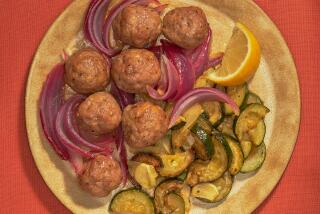If What’s on Top Hurts, Find a Slim Substitute
- Share via
It’s not the fettuccine, it’s the alfredo. It’s not the pancake, it’s the butter. It’s not the pizza, it’s the pepperoni.
With the spread of a knife or a scoop with a spoon, you can wreak havoc on nutritious foods by loading them with unhealthful toppings. Watching a carry-out sandwich-maker slather mayonnaise on once-virtuous turkey is enough to understand the phenomena. And then there are those who like a little lettuce with their salad dressing.
Some people still think starchy foods such as spaghetti or bread are fattening and should be avoided, report nutritionists. Not so. It’s the misguided diet plate of a hamburger patty and cottage cheese that packs the high-fat, high-calorie wallop.
The idea, then, is to find topping substitutes that add flavor without fat and calories. As you do so, the taste of the food itself should predominate, and fatty sauces and other additions will begin to taste greasy and heavy.
Another alternative: Simply exercise self-control. In other words, instead of a flood of butter on pancakes, add a smear.
Here’s the damage that can be done by villainous toppings, and some ways to minimize it.
--Pasta. A serving of fettuccine alfredo--made with heavy cream, butter and Parmesan cheese--contains almost as much fat as authorities recommended for an entire day. Even spaghetti with tomato and meat sauce (drained of fat) is a far better choice.
Team high-carbohydrate, low-fat pasta with chopped fresh tomatoes, fresh basil and a drizzle of olive oil and red-wine vinegar. Toss in some sliced zucchini or yellow squash, microwaved until slightly crunchy.
--Pizza. Hold the pepperoni, sausage and extra cheese and pizza is far from a junk food. Making pizza at home is easy, the toppings can be more easily controlled, and it is also a great way to use leftovers. Buy a refrigerated pizza shell (admittedly, not the optimal taste choice but it’s quick).
Dress it up with any combination of: chopped fresh red or yellow tomatoes, artichoke hearts, yellow or red pepper strips, cubed eggplant, sliced mushrooms, cauliflower or broccoli florets or red-onion rings. Go easy on the cheese--use part-skim mozzarella or a little of a more pungent cheese such as sharp Cheddar. Compensate with fresh chopped herbs and a lot of sauce.
--Bread. Two slices of whole-wheat toast have 140 calories and two grams of fat--a good breakfast with some fruit or whole-grain cereal and skim milk. But spread the toast with a pat of butter and you’ve tripled the amount of fat.
Instead, opt for a tablespoon of part-skim ricotta, low-fat cottage cheese or farmer cheese. Top either with apple butter or a sprinkling of cinnamon or nutmeg.
--Salads. A tablespoon of French dressing has 85 calories. An entire head of iceberg lettuce has 70.
When making dressing, reduce the proportion of oil to vinegar or omit oil entirely and use lemon juice, tomato juice or chicken stock as the base. Also, when preparing salad at home, dry the lettuce carefully; wet greens don’t absorb dressing as well.
When eating out, pay attention to the packets of dressings at fast-food restaurants and other carry-outs. You may be tempted to use the entire packet, many of them containing four tablespoons of dressing. A McDonald’s chef salad contains 230 calories; a packet of the fast-food restaurant’s ranch dressing is 330 calories.
--Fruits and Vegetables. Globs of sour cream, butter, hollandaise sauces or whipped cream can dramatically change the nutritional profile of produce. Obvious and oft-repeated substitutes include non-fat or low-fat plain yogurt.
For vegetables, spike yogurt with chives, garlic or chopped shallots; for fruit, combine with maple syrup, grated fresh ginger root, grated orange peel or fresh mint.
--Sundaes. Frozen yogurt is a classic vehicle for added dietary destruction. Syrupy nuts, hot fudge or chocolate-peanut-butter candies can turn a relatively virtuous food into a less-than-optimal one.
Top homemade sundaes with fresh fruit salad. Cut up a bunch of fruit, and you’re likely to use it. Already-cut fresh fruit will also come in handy as a topping for breakfast cereals or stirring into refrigerated yogurt for lunch. There are also a host of relatively new fruit syrups on the market that contain sugar but not fat.
--Seafood. A tablespoon of tartar sauce contains as many calories as a cup of crab meat and almost triple the fat. A tablespoon of butter is even worse. Cocktail sauce, though it can mask the flavor of fresh seafood, is a far better choice from a nutritional standpoint. Alternatively, many shellfish and mollusk aficionados prefer the sweet flesh of a lobster or scallop by itself.
And when it comes to tuna-salad sandwiches, there’s no reason to add mayonnaise to the salad and to the bread. Try mixing the tuna with yogurt, Dijon mustard and some fresh dill, and eliminate the mayonnaise entirely.
More to Read
Eat your way across L.A.
Get our weekly Tasting Notes newsletter for reviews, news and more.
You may occasionally receive promotional content from the Los Angeles Times.










